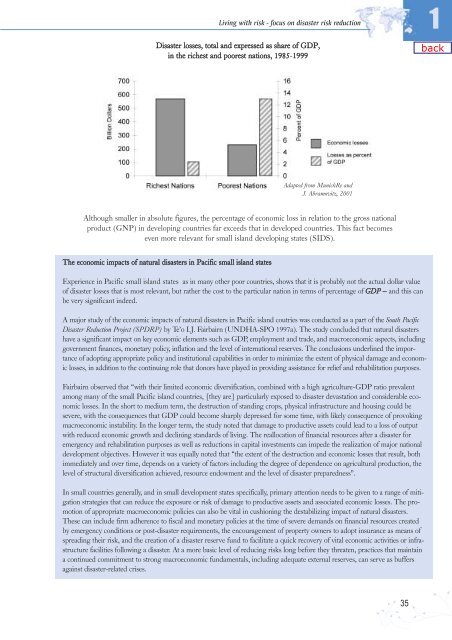Living with Risk. A global review of disaster reduction initiatives
Living with Risk. A global review of disaster reduction initiatives
Living with Risk. A global review of disaster reduction initiatives
You also want an ePaper? Increase the reach of your titles
YUMPU automatically turns print PDFs into web optimized ePapers that Google loves.
<strong>Living</strong> <strong>with</strong> risk - focus on <strong>disaster</strong> risk <strong>reduction</strong><br />
Disaster losses, total and expressed as share <strong>of</strong> GDP,<br />
in the richest and poorest nations, 1985-1999<br />
1<br />
Adapted from MunichRe and<br />
J. Abramovitz, 2001<br />
Although smaller in absolute figures, the percentage <strong>of</strong> economic loss in relation to the gross national<br />
product (GNP) in developing countries far exceeds that in developed countries. This fact becomes<br />
even more relevant for small island developing states (SIDS).<br />
The economic impacts <strong>of</strong> natural <strong>disaster</strong>s in Pacific small island states<br />
Experience in Pacific small island states as in many other poor countries, shows that it is probably not the actual dollar value<br />
<strong>of</strong> <strong>disaster</strong> losses that is most relevant, but rather the cost to the particular nation in terms <strong>of</strong> percentage <strong>of</strong> GDP – and this can<br />
be very significant indeed.<br />
A major study <strong>of</strong> the economic impacts <strong>of</strong> natural <strong>disaster</strong>s in Pacific island coutries was conducted as a part <strong>of</strong> the South Pacific<br />
Disaster Reduction Project (SPDRP) by Te’o I.J. Fairbairn (UNDHA-SPO 1997a). The study concluded that natural <strong>disaster</strong>s<br />
have a significant impact on key economic elements such as GDP, employment and trade, and macroeconomic aspects, including<br />
government finances, monetary policy, inflation and the level <strong>of</strong> international reserves. The conclusions underlined the importance<br />
<strong>of</strong> adopting appropriate policy and institutional capabilities in order to minimize the extent <strong>of</strong> physical damage and economic<br />
losses, in addition to the continuing role that donors have played in providing assistance for relief and rehabilitation purposes.<br />
Fairbairn observed that “<strong>with</strong> their limited economic diversification, combined <strong>with</strong> a high agriculture-GDP ratio prevalent<br />
among many <strong>of</strong> the small Pacific island countries, [they are] particularly exposed to <strong>disaster</strong> devastation and considerable economic<br />
losses. In the short to medium term, the destruction <strong>of</strong> standing crops, physical infrastructure and housing could be<br />
severe, <strong>with</strong> the consequences that GDP could become sharply depressed for some time, <strong>with</strong> likely consequence <strong>of</strong> provoking<br />
macroeconomic instability. In the longer term, the study noted that damage to productive assets could lead to a loss <strong>of</strong> output<br />
<strong>with</strong> reduced economic growth and declining standards <strong>of</strong> living. The reallocation <strong>of</strong> financial resources after a <strong>disaster</strong> for<br />
emergency and rehabilitation purposes as well as <strong>reduction</strong>s in capital investments can impede the realization <strong>of</strong> major national<br />
development objectives. However it was equally noted that “the extent <strong>of</strong> the destruction and economic losses that result, both<br />
immediately and over time, depends on a variety <strong>of</strong> factors including the degree <strong>of</strong> dependence on agricultural production, the<br />
level <strong>of</strong> structural diversification achieved, resource endowment and the level <strong>of</strong> <strong>disaster</strong> preparedness”.<br />
In small countries generally, and in small development states specifically, primary attention needs to be given to a range <strong>of</strong> mitigation<br />
strategies that can reduce the exposure or risk <strong>of</strong> damage to productive assets and associated economic losses. The promotion<br />
<strong>of</strong> appropriate macroeconomic policies can also be vital in cushioning the destabilizing impact <strong>of</strong> natural <strong>disaster</strong>s.<br />
These can include firm adherence to fiscal and monetary policies at the time <strong>of</strong> severe demands on financial resources created<br />
by emergency conditions or post-<strong>disaster</strong> requirements, the encouragement <strong>of</strong> property owners to adopt insurance as means <strong>of</strong><br />
spreading their risk, and the creation <strong>of</strong> a <strong>disaster</strong> reserve fund to facilitate a quick recovery <strong>of</strong> vital economic activities or infrastructure<br />
facilities following a <strong>disaster</strong>. At a more basic level <strong>of</strong> reducing risks long before they threaten, practices that maintain<br />
a continued commitment to strong macroeconomic fundamentals, including adequate external reserves, can serve as buffers<br />
against <strong>disaster</strong>-related crises.<br />
35

















